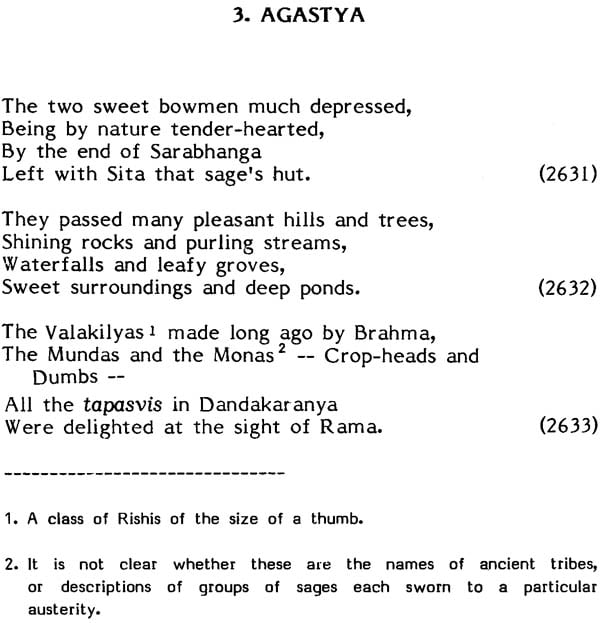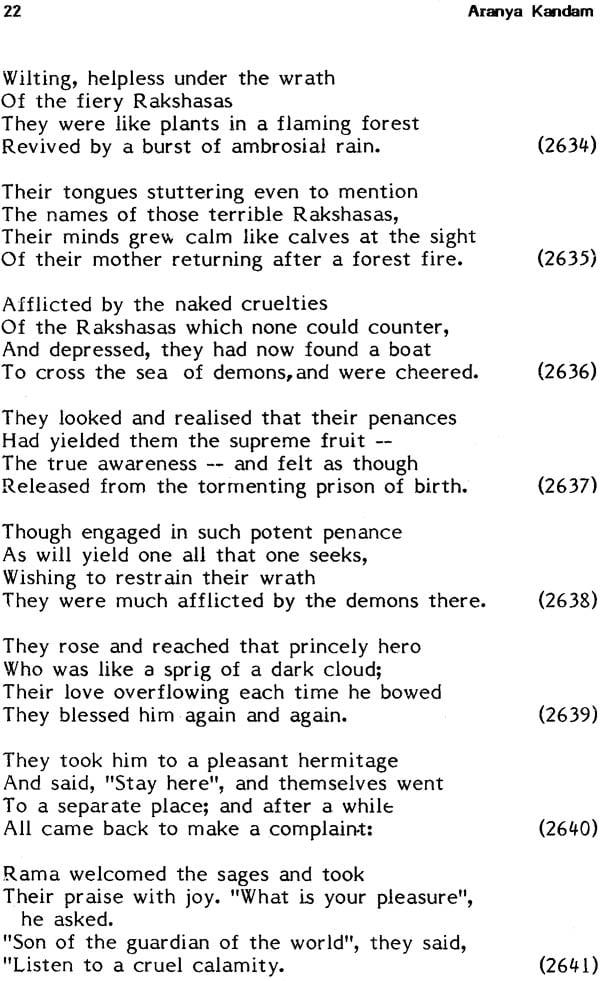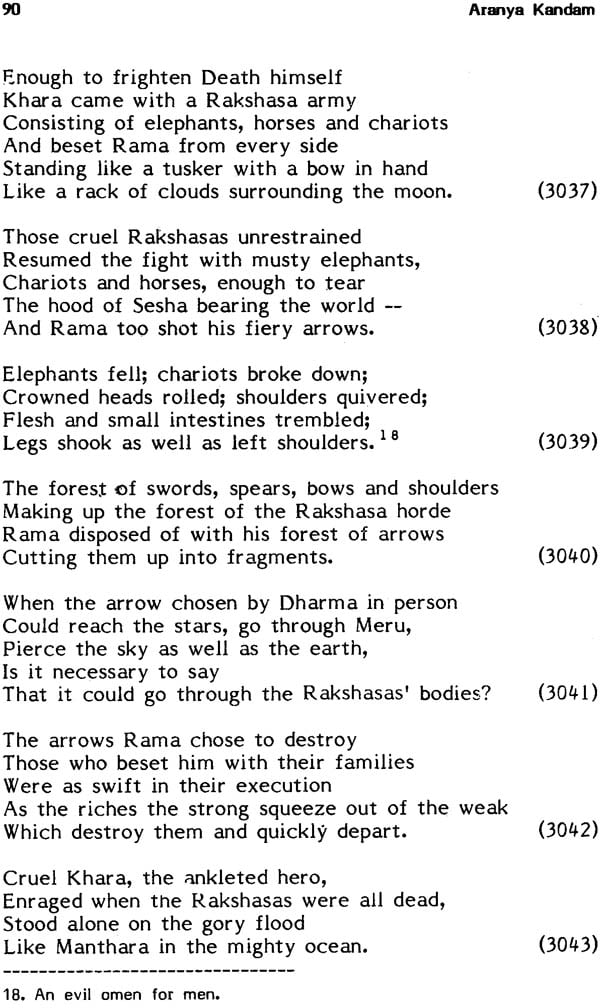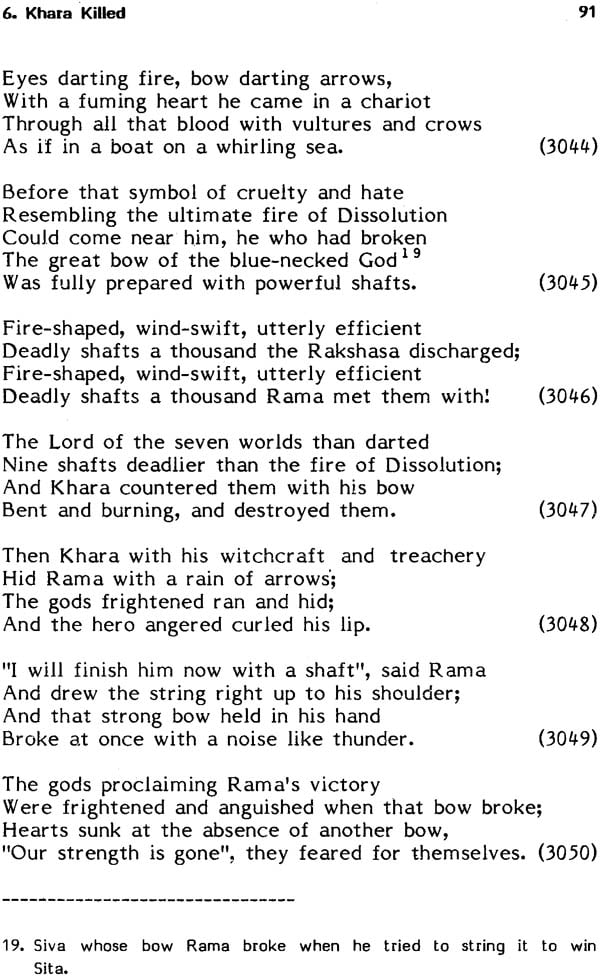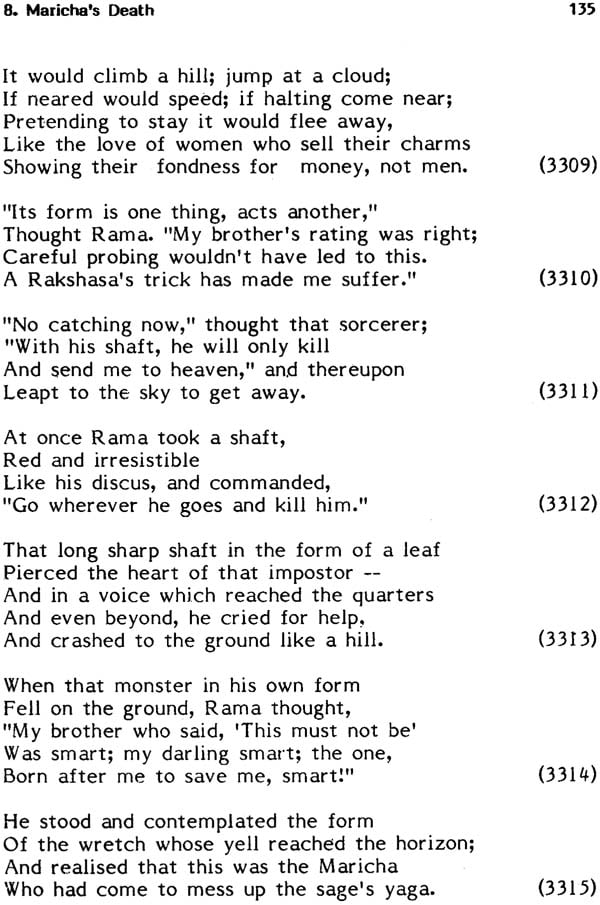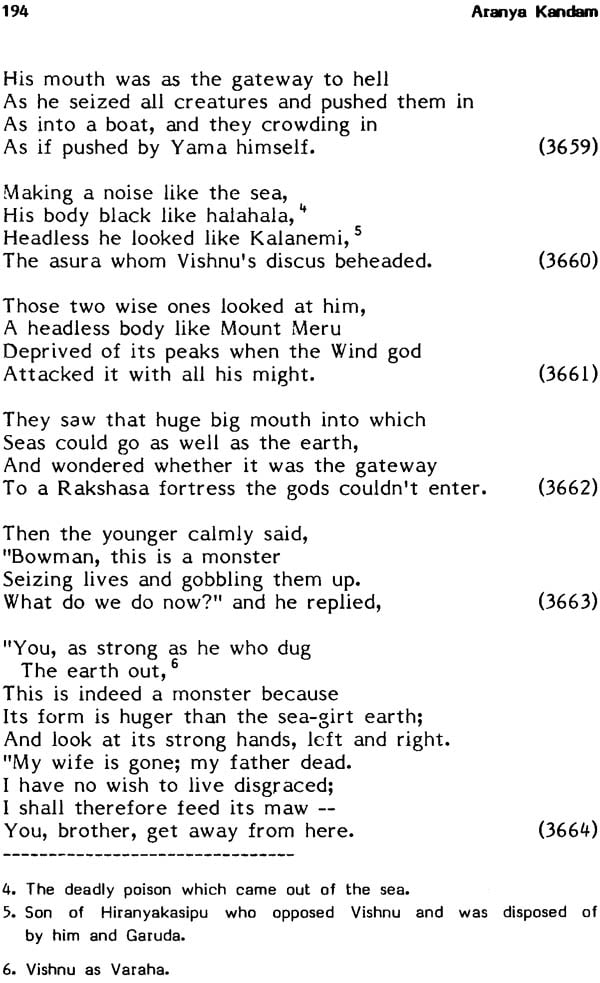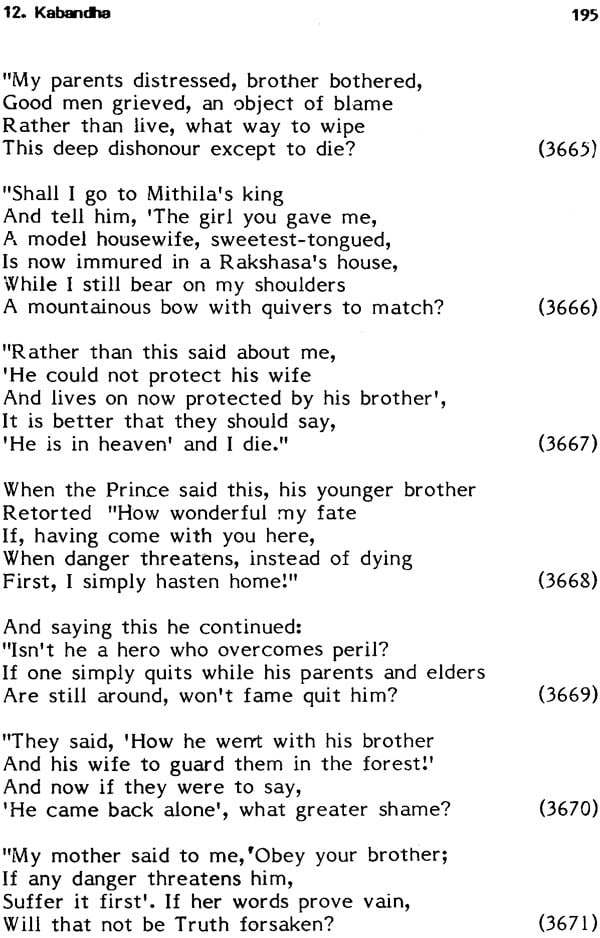
Kamba Ramayanam: Aranya Kandam (An Old and Rare Book)
Book Specification
| Item Code: | NAM314 |
| Author: | P. S. Sundaram |
| Publisher: | Department of Tamil Development Culture, Tamil Nadu |
| Language: | English |
| Edition: | 1991 |
| Pages: | 222 |
| Cover: | Hardcover |
| Other Details | 8.5 inch x 5.5 inch |
| Weight | 310 gm |
Book Description
One of the major objectives of the Government of Tamilnadu is to work for the development of Tamil and spreading of Tamil Culture. In addition to preserving the ancient Classics and creating the right kind of intellectual, climate for the birth of new works of art, our Government is particularly interested in getting all great writings translated from Tamil into English and from other languages into Tamil. This great task has been entrusted to a committee consisting of experts in the field of translation.
It is rather unusual that an English translation of such an exquisite epic of Kamban comparable perhaps to the best of its kind in any language has, somehow, not so far been attempted in full. To straighten out the short coming, the Government came forward to pursue the project and chose Professor P.S. Sundaram, M.A. (Oxon) to undertake this remarkable endeavour. The English version of Bala Kandam was published last year and now we are happy to release Ayodhya Kandam and Aranya Kandam.
Translation is an art as well as a science, and translating poems from one language into another is a particularly difficult task. When the two languages happen to be as different from each other as Tamil and English, the Translator’s job becomes unenviable. We can never be certain that we have achieved a definitive translation. There will always be scope for improvement and it is good to encourage renewed attempts especially when the works happen to be as excellent an epic as the Kamba Ramayanam. But this does not mean that the superb rendering by Professor Sundaram who, in his eighties, has set his heart on this labour of love, can ever be underestimated.
Although certain elements of the epic are perhaps disputable, there cannot be any question regarding the poetic excellence of Kamban which will continue to please generations.
Let me, therefore, congratulate the Department of Tamil Development and Culture and the Translator on their bold attempt to fulfil a long-felt need. I commend the work to all the readers in search of classics of perennial charm.
The Aranya Kandam may be regarded as the most significant of the seven cantos which make up the Ramayana story. Mahavishnu left his serpent-bed on the milky ocean in order to rid the gods and men of the incubus that was Ravana, and it is when Ravana enters the story that the first step is taken towards this consummation. All that leads to Sita’s abduction is the prologue, and the war between Rama and Ravana, whose like the poet says has never been seen on earth, is the last act of the drama. The Uttara Kanda, which is attributed to Valmiki and might or might not have been written by him, is the epilogue, and Kamban’s version of the story does not contain it.
Kamban differs from Valmiki in certain minor particulars which are not of much significance, and also in some major particulars which are. Thus the rishi Sarabhanga in Kamban enters the fire not by himself but with his wife. When Rama enters the rishi’s ashrama, Indra was there. In Valmiki, Indra does not want to meet Rama, saying to the Rishi that he will meet him after he has done the work which he alone can do—and a scholiast interprets this to mean that if Indra should reveal himself to Rama (and presumably inevitably worship him), Rama will realise that he is more than a man, and that will interfere with the boon obtained by Ravana that no god will be able to kill him. Kamban not only makes Indra meet Rama but also makes him tell Rama that he is none other than Vishnu, and what a shame it is that he should put himself to all this trouble to rid the world of the Rakshasas!
Kamban in fact never lets slip any opportunity to hymn Rama’s praise as of God. Not only Indra but Viradha, Sarabhanga, Kabandha, Sabari realise his divinity and act towards him accordingly. There is reason to believe that Kamban was familiar with the Adhyatma Ramayana where Rama is thought of throughout as God, not a man, whereas in Valmiki the emphasis is more on Rama the man. Kamban’s approach is a blend of both these attitudes, in certain contexts as in the Bala kandam when he sees Sita for the first time stressing the human aspect, but more and more as the story proceeds emphasizing the divine.
In portraying Sita, Kamban omits many things in Valmiki which present her as not only a beautiful but also a spirited woman. In the original poem she tells Rama at great length that it will ill become him as an ascetic to declare war against anyone who has not offended him personally, and that there is no sense in his inviting trouble by promising the sages that he will exterminate the Rakshasas. When she hears the loud cries of Maricha she leses control over her temper and tongue and, unable to understand Lakshmana’s being still with her and not rushing to his brother’s rescue, accuses him of the vilest motives.
Curiously enough, Kamban does not make Maricha cry, “O Lakshmana, O Sita’” in Rama’s voice—which is the operative trick–but only says in general terms that the noise Maricha made on being shot by Rama’s arrow reached the horizon. It is Rama who after the event says,
“When my shaft pierced him,
The mean wretch, using his witchcraft
Called out in my voice; and my poor wife,
Her eyes flooded with tears, will wit.”
Rama too in Valmiki is severe with Lakshmana for having disobeyed him and come in search of him leaving Sita alone. Even after Lakshmana explains to him how he was forced to come, he only finds fault with him for obeying a distracted woman and leaving her behind, perhaps because he was angry with her.
Kamban in this instance improves on Valmiki, making Rama absolve Lakshmana of all offence, by saying graciously,
“Your coming away in no fault of yours
As it was caused by the anxiety
Of one pertured in mind, which absolves you;
Alas! disaster fell then”, he said,
”When your clear-minded prevented me
And I didn’t listen, but did what I did.”
There is nothing corresponding to this is Valmiki. When Sita, in Valmiki, twits Lakshmana attributing vicious motives to him, Lakshmana replies;
“Fie on you who be bringing destruction
upon your own head this very day, for thus
Suspecting me, who have been faithful to my revered brother’s orders. In this you have
acted like all women, obeying your evil disposition”.(Raghunathan’s translation).
Tulsi Das dealing with the situation finds this an excellent opportunity to give vent to his own rooted distrust of woman as a snare, a mystery and an ungovernable creature. Rama tells Lakshman in connection with the loss of Sita,
However carefully the scriptures are studied, they must be read over and over again; however well a king may be served one can never regard him as subject to one’s influence; and though one keeps a wife next to one’s heart, if she be young, she is no more mastered than the scriptures or a king.(Translation by W.D.P. Hill)
It is to Kamban’s credit that he does not indulge in any such generalisation in connection with Sita’s impatience and ager. Her annoyance with Lakshmana is only because of his seeming indifference to Rama’s fate. She does not attribute any base motive to him. She threatens to fall into the fire only because she cannot live without Rama. The question of her not wanting to be Lakshmana’s wife or concubine is not raised.
The exaggerated notion regarding sexual purity—that the very touch of any man other than her wedded husband or her sons in their infancy is a pollution—finds expression in the way in which Ravana is made to carry Sita away not as in Valmiki clasping her body but, as in the Adhyatma Ramayanam, digging up the earth under her feet and taking her with the hut in which she was. If it is pleaded that this was because of the curse on Ravana, that if he took any woman against her wish, his head would split into atoms, the answer is that this applies to the Ravana of Valmiki as well as to the one of Kamban or the Adhyatma Ramayanam. “Taking a woman” in this context cannot mean even so much as touching her.
But Kamban who does not make that distinction is at least free to the legerdemain by which in the Adhyatatma Ramayanam and in Tulsi Das the Sita whom Ravana takes away is only a maya Sita, not the real one, the real Sita having been asked by her husband to enter fire before he sets out to catch the golden deer. The maya Sita who comes out of the fire can then, after Ravana is killed, be made to enter a fire in Lanka, so that the real one can now step out of it, and “All be as before, Love, Only sleep”.
“Life”, say our philosophers, “is all a delusion anyhow” and pious souls will not jib at swallowing a few sleights o hand like this. But was all Rama’s lament after he kills Maricha and finds Sita gone only an elaborate play-acting, not only for the benefit of Lakshmana but also even of himself? Has almighty God, the great mayavi, been caught in his own maya and is unable to escape from it? The pious will of course say, without batting an eyelid, “Yes. Otherwise how will the maya be complete?” But Kamban does well not indulge in such cheap claptrap.
In Valmiki, Ravana takes Sita first to his palace, tempts her with all the opulence there and, only after she rejects it with scorn, sends her to the Asoka grove. In Kamban this intermediate stage is avoided.
In portraying the character of Rama, Kamban avoids anything that might be considered unworthy of him. For example, Rama does not send Surpanakha to Lakshmana saying that the latter is unmarried and therefore should be preferred by her to him. He realises, not late as in Valmiki but right at the beginning, that one must not jest with the mean-minded. It is not at his order that Lakshmana disfigures Surpanakha but on his own, and when Rama is not present to see what is happening or is being contemplated. When he sees Jatayu wounded, he does not rush at him, arrow fitted to bow, thinking that he is probably a Rakshasa who has made a meal of Sita. His praise of Lakshmana’s wisdom in guessing the true nature of the deer of gold is also generous and heart warming.
| Foreword | v | ||
| Introduction | xi | ||
| 1 | Viradha Killed | 2516-2586 | 1 |
| 2 | Sarabhanga's Death | 2587-2630 | 13 |
| 3 | Agastya | 2631-2689 | 21 |
| 4 | Jatayu | 2690-2731 | 31 |
| 5 | Surpanakha | 2732-2874 | 39 |
| 6 | Khara Killed | 2875-3066 | 65 |
| 7 | Surpanakha's Stratagem | 3067-3236 | 95 |
| 8 | Maricha's Death | 3237-3318 | 123 |
| 9 | Ravana's Stratagem | 3319-3402 | 137 |
| 10 | Jatayu Dying | 3403-3540 | 151 |
| 11 | Ayomukhi | 3541-3642 | 175 |
| 12 | Kabandha | 3643-3698 | 191 |
| 13 | Sabari | 3699-3707 | 201 |
